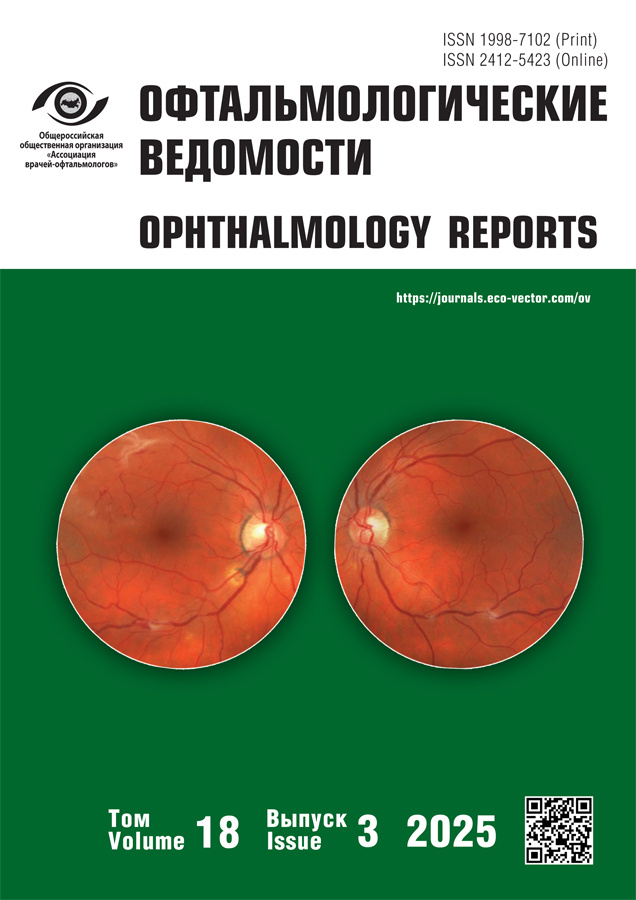Case report of astrocytic hamartoma associated with tuberous sclerosis
- Authors: Mikhailov D.S.1, Sorokin E.L.1,2
-
Affiliations:
- S. Fyodorov Eye Microsurgery Federal State Institution
- Far-Eastern State Medical University
- Issue: Vol 18, No 3 (2025)
- Pages: 49-56
- Section: Case reports
- Submitted: 26.03.2024
- Accepted: 12.02.2025
- Published: 30.09.2025
- URL: https://journals.eco-vector.com/ov/article/view/629448
- DOI: https://doi.org/10.17816/OV629448
- EDN: https://elibrary.ru/MLKSRE
- ID: 629448
Cite item
Abstract
Astrocytic hamartoma is a quite rare disease secondary to tuberous sclerosis and is challenging to identify at the initial ophthalmological examination. The article presents a case report of retinal astrocytic hamartoma secondary to tuberous sclerosis in a 42-year-old male patient. OD ophthalmoscopy revealed a space-occupying, oblong, subretinal, slightly elevated, light yellow lesion of 1.5 disc diameters, with a bumpy surface (resembling a mulberry) at 4–5 o’clock along the inferior nasal vascular arcade. In the left eye, a space-occupying, subretinal, light yellow lesion of 1.5 disc diameters resembling a mulberry was visualized along the superior vascular arcade. A subretinal, flat, gray lesion of about 1.5 disc diameters was observed along the inferior nasal arcade. Magnetic resonance imaging showed multiple lesions (tubers) of altered magnetic resonance signal intensity in the middle cranial fossa, which were typical for tuberous sclerosis. Age of onset, clinical manifestations, and location of tubers in the presented case report are quite consistent with the published data. The presented case report demonstrated challenges of determining etiology of astrocytic hamartoma diagnosed at initial ophthalmological examination.
Full Text
About the authors
Denis S. Mikhailov
S. Fyodorov Eye Microsurgery Federal State Institution
Author for correspondence.
Email: nauka2khvmntk@mail.ru
ORCID iD: 0009-0002-4633-2249
Khabarovsk branch
Russian Federation, KhabarovskEvgenii L. Sorokin
S. Fyodorov Eye Microsurgery Federal State Institution; Far-Eastern State Medical University
Email: nauka2khvmntk@mail.ru
ORCID iD: 0000-0002-2028-1140
SPIN-code: 4516-1429
Khabarovsk branch, MD, Dr. Sci. (Medicine), Professor
Russian Federation, Khabarovsk; KhabarovskReferences
- Kuklin IA, Kenikfest YV, Volkova NV, et al. Pringle-Bourneville disease: diagnosis at the intersection of disciplines. Modern Problems of Dermatovenereology, Immunology and Medical Cosmetology. 2010;(4):55–62. EDN: MVIHCT
- Astakhov YS, Nechiporenko PA, Atlasova LK, et al. Retinal astrocytic hamartoma in tuberous sclerosis. Ophthalmology Reports. 2017;10(1):97–101. doi: 10.17816/OV10197-101 EDN: YNAGUL
- Sedova TG, Elkin VD, Kobernik MY, et al. Tuberous sclerosis: literature review and clinical case report (retrospective analysis of 15-year follow-up). Russian Journal of Clinical Dermatology and Venereology. 2021;20(1): 136–144. doi: 10.17116/klinderma202120011136 EDN: HIOMLT
- Yusupova LA, Garaeva ZS, Yunusova EI, et al. Bourneville-Pringle disease. Lechaschi Vrach. 2012;(10):18. (In Russ.) EDN: SITIQZ
- Melnikov AA, Dyachenko VV, Fraiter EV. A case of primary diagnosis of Bourneville-Pringle disease based on magnetic resonance imaging. Eurasian Union of Scientists. 2015;(4–7(13)):133–134. EDN: XDSAMD
- Romanenko KV, Romanenko VN, Naletov SV, et al. Tuberous sclerosis complex (Bourneville–Pringle disease). Archive of Clinical and Experimental Medicine. 2020;29(3):289–295. EDN: LMOVAT
- Dorofeeva MY, Pivovarova AM, Perminov VS, et al. Tuberous sclerosis. Russian Medical Journal. 2004;(3):52. EDN: OIQMMR
- Rowley SA, O’Callaghan FJ, Osborne JP. Ophthalmic manifestations of tuberous sclerosis: a population based study. Br J Ophthalmol. 2001;85(4):420–423. doi: 10.1136/bjo.85.4.420
- Wong EN, Fraser-Bell S, Hunyor AP, Chen FK. Novel optical coherence tomography classification of torpedo maculopathy. Clin Exp Ophthalmol. 2015;43(4):342–348. doi: 10.1111/ceo.12435
- Tripathy K, Sarma B, Mazumdar S. Commentary: Inner retinal excavation in torpedo maculopathy and proposed type 3 lesions in optical coherence tomography. Indian J Ophthalmol. 2018;66(8):1213–1214. doi: 10.4103/ijo.IJO_656_18
- Olshanskaya AS, Schneider NA, Dmitrenko DV, et al. Differentiation of retinal astrocytic hamartoma from other retinal neoplasms: a case report. Siberian Journal of Oncology. 2017;16(5):93–99. doi: 10.21294/1814-4861-2017-16-6-93-99 EDN: YLBCMX
- Saakyan SV, Khoroshilova-Maslova IP, Amiyan AG, et al. A clinical and morphological analysis of a retinal and optic nerve astrocytic hamartoma case. Russian Ophthalmological Journal. 2021;14(2):76–80. doi: 10.21516/2072-0076-2021-14-2-76-80 EDN: GYYQJK
- Mosin IM, Dorofeeva MY, Balayan IG, et al. Ophthalmic manifestations of tuberous sclerosis. Russian Bulletin of Perinatology and Pediatrics. 2012;57(5):77–81. EDN: PFJBGN
- Lagan P, Sumit K, Shalini S, et al. Multiple retinal astrocytic hamartomas in siblings with lebers congenital amaurosis: a case series and review of literature. BMC Ophthalmol. 2020;20(1):377. doi: 10.1186/s12886-020-01646-z EDN: ZVKIBE
- Zhou N, Zhang H, Duan J. A giant astrocytic hamartomas on optic disc. Asia Pac J Ophthalmol (Phila). 2022;11(5):493. doi: 10.1097/APO.0000000000000457 EDN: YNYUJC
- Mishra C, Kannan NB, Ramasamy K, et al. Retinal astrocytic hamartoma in tuberous sclerosis. Indian Dermatol Online J. 2019;10(6):753–754. doi: 10.4103/idoj.IDOJ_23_19
- Matveev VB, Volkova MI, Gurariy LL, et al. Giant renal angiomyolipomas as a manifestation of Bourneville–Pringle disease. Oncourology. 2011;(3):132–136. EDN: OIPOWL
- Stoyukhina AS. Local calcification as one of the causes of misdiagnosis of chorioretinal lesions. Ophthalmology Reports. 2019;12(3):31–39. doi: 10.17816/OV15931 EDN: SJFMVP
- Dyuzhakova AV, Olshanskaya AS. Pringle-Bourneville disease (tuberous sclerosis). In: Proceedings of the XII Scientific-Practical Conference of Dermatovenereologists and Cosmetologists. Public organization: Man and His Health; 2018. P. 167–169.
- Dumitrescu D, Georgescu EF, Niculescu M, et al. Tuberous sclerosis complex: report of two intrafamilial cases, both in mother and daughter. Rom J Morphol Embryol. 2009;50(1):119–124.
- Hurst JS, Wilcoski S. Recognizing an index case of tuberous sclerosis. Am Fam Physician. 2000;61(3):703–8, 710.
- Umeoka S, Koyama T, Miki Y, et al. Pictorial review of tuberous sclerosis in various organs. Radiographics. 2008;28(7):e32. doi: 10.1148/rg.e32
- Chen XZ, Dai JP. Tuberous sclerosis complex complicated with extraventricular cystic giant cell astrocytoma: case report. Chin Med J (Engl). 2007;120(9):854–856. doi: 10.1097/00029330-200705010-00024
- Bakunovich AV, Sinitsyn VE, Onopchenko EV. A case of tuberous sclerosis complicated by unusually located subependymal giant cell astrocytoma. Bulletin of Radiology and Radiobiology. 2013;(3):51–54. EDN: REVWRX
- Ishii M, Asano K, Kamiishi N, et al. Tuberous sclerosis diagnosed by incidental computed tomography findings of multifocal micronodular pneumocyte hyperplasia: a case report. J Med Case Rep. 2012;6(1):352. doi: 10.1186/1752-1947-6-352
- Sharma P, Rao K. Psychological intervention in tuberous sclerosis: a case report. Indian J Psychiatry. 2002;44(4):391–396.
- Wee SA, Fangman B. Tuberous sclerosis. Dermatol Online J. 2007;13(1):22.
Supplementary files













